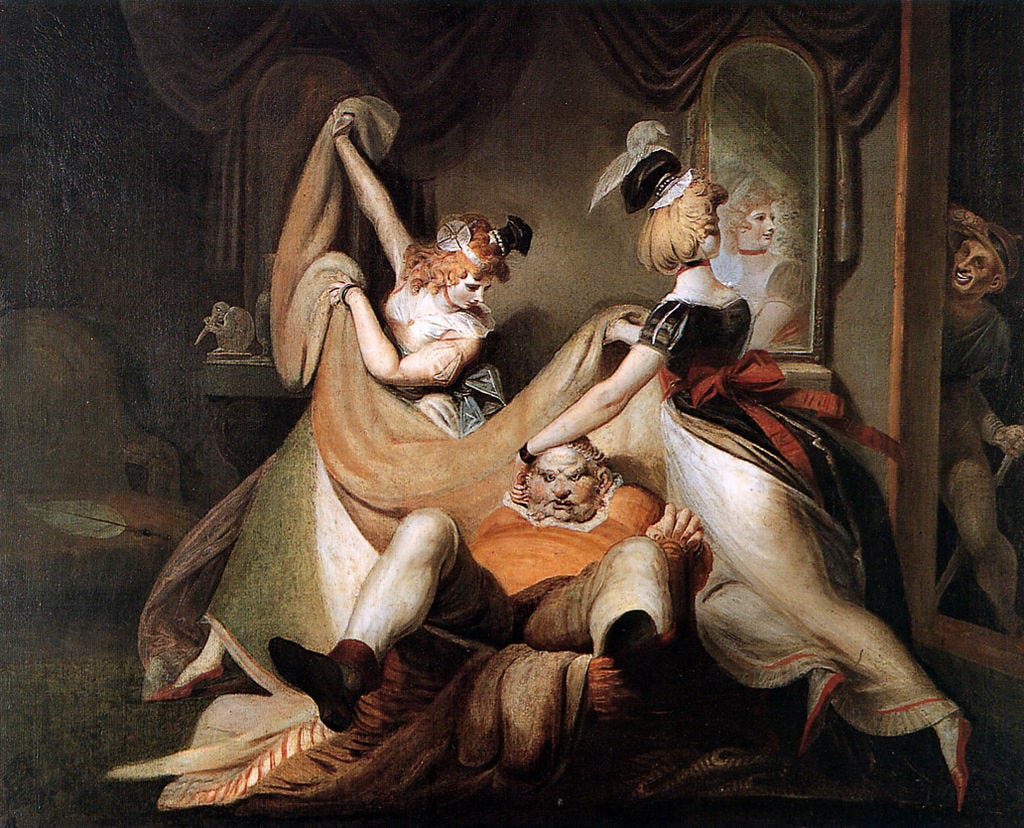The holes Paul George left in L.A.
The Clippers are going to be really weird without their star.
Good morning. Let’s basketball.
Falstaff in the Laundry Basket; Henry Fuseli; 1792
Last week in assessing the Western Conference as it pertains to disrespect, I slotted the Clippers in Tier 3 with teams Nos. 7 to 12. I didn’t think a whole lot about this — the Clippers have been better than that most years, but also lost Paul George without replacement, and are again thin up front after Mason Plumlee bolted. I stand by the tier assignment. With Kawhi Leonard, James Harden, Ivica Zubac, Terence Mann, Norm Powell, Nicolas Batum and Derrick Jones Jr., there is a definite base talent level here. The question is whether that base talent level can compete with those around them with more vital star talent.
Since that brief thought exercise, I’ve been thinking more about the post-PG Clippers, and what they’ll really miss.
The first thing that comes to mind is the high-minute soaking quality. Regardless of what you think of George’s abilities as a star, his teams have always been pretty good at worst, and they are always competitive with him on the floor. Paul led the Clippers in minutes played last year. You are definitionally removing a known plus player from 2,500 minutes and substituting in a mix of lesser players, plain and simple. I don’t think there are any hidden future All-Stars on this roster, and DJJ — who figures to be the closest replacement — is nothing like the overall player that PG has been. In the 20,000 or so minutes a team needs to assign over the course of 82 games, the Clippers had an A or A- player assigned to 2,500 of them, and now there’s a B- or C+ player in that spot.
The second thing that rises up is the fact that the Clippers relied on offense to buoy them last season — the defense has been below average for two consecutive years — and PG was a major buoy for the offense. L.A. finished No. 4 in offensive efficiency last season, finishing top-10 in shooting efficiency and No. 5 in foul drawing. PG was the worst of the three stars in terms of getting to the line, but his foul-drawing was still important, and it’s something that it seems hard to imagine any other Clippers soaking up unless Harden takes on a bigger offensive role. (We’ll get back to that.) PG was also the Clippers’ most prolific three-point shooter, hitting 41% at 7.9 attempts per game. George finished fifth in three-point makes last season and surprisingly sits No. 11 all-time. He’ll leap into the top 10 in this category within the first couple weeks of the season.
Simply put, it’s hard to replace that much deep shooting. The Warriors are in this position, too. Klay Thompson is not Paul George, but Klay did take nine threes per game last season. The one wrinkle for L.A. here is that Harden had a much-reduced offensive role in 2023-24, likely due to his interest in fitting in and facilitating for Kawhi and PG. (Steph Curry, on the other hand, is already likely operating at peak volume. Maybe.) The Beard has a mandate to do more, and could soak up a big part of PG’s shooting responsibility, but the context of James Harden shooting 10+ threes is very different than the context of Harden and PG each shooting 7 or 8. Unless DJJ or Mann become knockdown shooters — both are infrequent and inefficient deep shooters for their careers — the Clippers’ offense is either going to get more shallow or more predictable. Harden is not the same player he was 5, 6, 7 years ago. The lower usage rate (20% last season, down from 25% in Philly, the high-20s in Brooklyn and as high as 40% in Houston) is partially about role and fit. It’s also partially about a player who has never focused on being in immaculate shape reaching his mid-30s.
You wonder if Ty Lue will insert Powell — who has been the Clippers’ top reserve in most cases — as the fifth starter with Zubac, Leonard, Mann and Harden.
Keep reading with a 7-day free trial
Subscribe to Good Morning It's Basketball to keep reading this post and get 7 days of free access to the full post archives.



